Rosie Shuster Saturday Night Live Alumni
- Details
- Category: Interviews
- Published on Saturday, 22 December 2018 16:18
- Written by Dianne V Lawrence
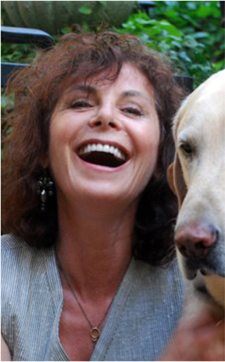
TNN: Rosie, why don't you start by telling us how Saturday Night Live came to be?
Rosie: I have to start really, really far back when Lorne, then Lipowitz, followed me home from school when I was 14 years old.
TNN:You're referring to Lorne Michaels
Rosie: At my mother's insistence, Lipowitz became Michaels. My father was in a comedy team in Canada called Wayne and Schuster and they were performing on Ed Sullivan shows, which were live from New York on the weekend.
TNN: I grew up watching your dad on Ed Sullivan. My father loved Wayne and Shuster!
Rosie: It was a Sunday night, live comedy variety show watched by all of North America, so there was a template that went way, way, way back. Lorne and I also went way back. We did comedy sketches together at high school, summer camp and college. Howard Shore was involved in some of those camp shows. I went on to write with Lorne for Canadian television, including the Hart and Lorne show for CBC. Just like my dad, he found a shorter, funnier Jewish guy to be his comedy partner. He played the straight man, but his real talent was in producing. Bringing people together. Danny Aykroyd and Gilda Radner were on a few of those shows. So Lorne's career began to really resemble my dad's comedy career and that became the nucleus of SNL. I also came to Los Angeles and worked with Lorne on a Lily Tomlin series for ABC. Laraine Newman was there. Marilyn Miller, who was also an early writer for SNL, was also one of the writers for Lily’s show. So, when SNL was going to happen in New York City, of course I went along.

TNN:What was it like when you all got together in the room that first time and you were ready to produce the very first show.
Rosie: The group got together in late August and the first show aired on October 17th. There was a long incubation period where everybody was kind of falling in love with each other and cracking each other up, trying to find their place, have a voice. We were stockpiling a lot of commercial parodies. You could feel something organically happening amongst us.
TNN:Where did Lorne draw people from?
Rosie: Gilda, Danny, Belushi and later Bill Murray came from the Chicago and Toronto Second City. Then there was Chevy and Michael O'Donoghue, who came from the Lampoon. Laraine Newman came from the Groundlings in LA.. Garrett Morris started off as one of the writers. Michael O’Donaghue was an important force shaping the show in the early days. His humor was very exact and precise. He crafted lines that were honed to a voodoo acupuncture point.
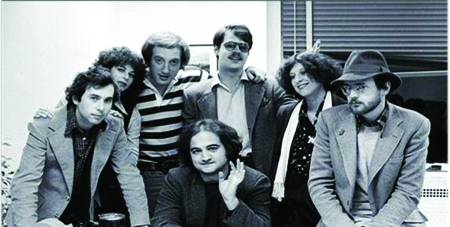 L-R Tom Schuller, Rosie, Allan Zwiebel, Dan Ackroyd, Elaine Miller, Michael O'Donaghue, John Belushi in front.
L-R Tom Schuller, Rosie, Allan Zwiebel, Dan Ackroyd, Elaine Miller, Michael O'Donaghue, John Belushi in front. TNN:So it took, what? Two or three months before the first show happened?
Rosie: It took just under two months and don’t forget, it was live, which was unique at the time. You have to remember in the mid-seventies, there was Watergate and Vietnam. Rock music had broken out in the sixties as well as a lot of films like the Jack Nicholson kind of movies, Five Easy Pieces. They reflected the revolution in consciousness that came out of the sixties but television was still square as hell. So part of the impetus of the whole show was to just shake things up and to reflect back what was happening in the culture, the edginess and spontaneity that wasn’t happening on television.
TNN:Talk about the very first show.
Rosie: The first show was George Carlin, who was flying on blow. Nobody got close to him. He didn't integrate with the cast. There were a lot of sketches on that first show. I created a commercial parody called “New Dad. Tops and Pops.” If you lose your husband, sure you're covered financially but what about your physical needs? I came up with this other surreal idea around bee’s. One liner ideas, like the bee hospital. “Congratulations! It's a drone. Congratulations. It's a drone. Congratulations. It's a drone.” They set me up in great opposition with John Belushi and put him in a bee outfit with the little antenna bopping around. He was like a macho man in these fruity ass bee costumes. People loved it. Lorne used to like to put them in those costumes.
TNN:What were some other pieces you created that we would recognize?
Rosie: Well, the Nerds got really popular. Bill Murray and Gilda Radner playing Todd and Lisa.
TNN:That was one of yours!?
Rosie: Yes, and the first ever Roseanne Roseannadanna also played by Gilda, was in a sketch I wrote. It was like a public service announcement that encouraged people to “Hire the Incompetent.” She had that big wig but didn't have the name yet. Gilda mentions my name in her book “Love Gilda.” I used to write some surreal public service things. I wrote the first ever Emily Litella with Gilda. It was based on her nanny.
TNN:Which one was the Emily Litella character?
Rosie: The little old lady who was always hard of hearing and sat on News Update with Chevy and would have complaints like “What's all this I hear about presidential erections!” Chevy would correct her “It’s ELECTIONS!” and she would respond with “Oh, that's very different… nevermind.” I also wrote some of the Baba Wawa sketches, [a take-off on Barbara Walters] a character Gilda brought in. I wrote a lot of these with Anne Beatts. We wrote in a team.
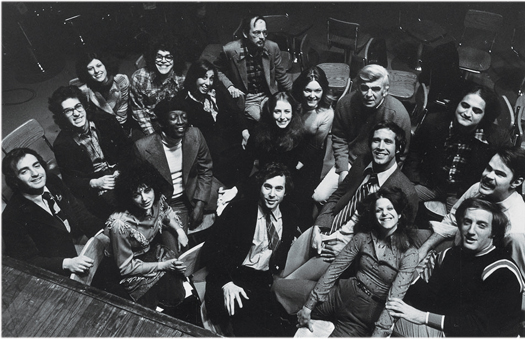
TNN:Let’s talk about women in comedy at that time. We had Lucy, we had Mary Tyler Moore…
Rosie: Elaine May was a comedy god in the sixties. As far as pure sketch comedy, Lily Tomlin was supreme. There was one early piece that I wrote with Ann for Lily Tomlin called “The Hard Hats” but no guy wanted to play the sex object. Belushi couldn't handle it and finally, Lorne made Danny do the sketch. We really did have to break a lot of glass ceilings because guys talk to each other and it was difficult for a woman to insert a female point of view into the conversation. Now there are a lot of strong women in comedy, but in those days there weren't.
TNN:What was the work schedule like? You had to create a show from scratch in five days.
Rosie: Monday the host came in and we pitched ideas to them. It usually was an early night. Tuesday we came in at noon. It was the day all of the writing happened and we worked through the night sometimes into Wednesday morning. Wednesday was the read through and you were just hallucinating by then. Beatts and I would often write around three sketches.
Saturday Night Live was unique in that if you wrote a piece, you went to costumes and said what you needed, you went to props, you went to the scenic design and said what you were thinking of. There wasn't time for Lorne to do too much of that. He did some top down producing and some course correcting, but we actually got to mount and do our own little productions, so that was pretty cool.
After read through, Lorne would sit with the host, go over all the sketches and the ones they liked went on cards. The cards were then placed up on a board to get an overview of the show. There was also the News Updates segment, little films and musical guests that filled out the ninety minutes.
Thursday and Friday were for camera blocking; you blocked half of it on Thursday and half of it on Friday.
Then Saturday was a monster day. There was a tech-run through, then dress rehearsal with an audience. After dress rehearsal we all met in Lorne's office where some things got cut, some things got tightened and then suddenly we had a live show. And an occasional baffled host was just like, “What? This is live? Wait, When do we tape?” A few were pretty drunk at dress. Then Sunday off, if you got home. I often got home at 6 am.
At some point Danny and John had the Blues Bar and slowly over time you started to see all these A-list celebrities hanging out. The whole thing mushroomed into something crazy nobody could have anticipated. There really was nothing like it. And because it was live from New York, there was a danger element to it that no TV had. It wasn’t Perry Como singing songs on a couch.
TNN:How did people sustain the energy?
Rosie: We burned out like crazy. There were drugs, some people went nuts. There were relationship and marriage split ups, and the stress showed. People just blew gaskets. It was too much. You got burned out and very self-referential 'cause your whole life had become the show. You really didn't have that much time to live a life and see what was happening with other people. It became a bubble.
TNN:How long were you there for?
Rosie: I was there for the first five years. Then I was off and on through the eighties. I helped create the Church Lady with Dana Carvey and wrote a bunch of Church Chats. I wrote a Tyrone sketch for Eddie Murphy that he used when he was being honored for the Mark Twain Award at the Kennedy Center.
TNN:What are some of other things that you've done?
Rosie: Well I wrote for the Broadway show, Gilda Live with Michael O'Donoghue, Marilyn Miller, Alan Zweibel and Anne Beatts. It was a big hit at the Winter Garden Theatre with Mike Nichols directing. He then turned it into a film! It was really sweet. I made a movie with Mike Nichols! In the early nineties I was a writer and producer for the Carol Burnett Show. I also did the Larry Sanders Show with Gary Shandling and one of my scripts got an Emmy nomination and a Cable Ace nomination. I also wrote a lot of movie scripts for MGM, Tristar, Warner Brothers and Orion.
TNN: Rosie! Wow!
Rosie: And it all started with Lorne following me home from school and saying hello to my father.
10th Anniversary. Couldn't Have Done It Without Them
- Details
- Category: Interviews
- Published on Monday, 20 August 2018 18:45
- Written by D.V. Lawrence
First - The following people gave much-needed support in the beginning either through encouragement, donations, sharing their experience in publishing, or all three.
Buck Henry and Irene Ramp, Cecilia Uribe, Denise Domergue, Gary Kemper, Jay Levin, Laura Meyers, Leonard Cohen, Peta J. Torokvei, Steve Wallis, The Marketing Action Group Network.
Then - the following women miraculously showed up just when TNN needed them. Their ongoing dedication and commitment in the early years was instrumental in helping to establish a solid foundation for the paper.
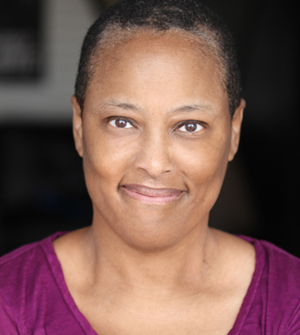 DAWN KIRKPATRICK
DAWN KIRKPATRICKI found out about TNN when I moved to Mid-City, LA., over seven years ago from Ann Arbor, Michigan. I ran across a copy while shopping at Ralph’s one day. At the time I was looking for ways to get writing samples. I remember finding a phone number to contact the publisher of TNN, or Dianne, and called her. She enthusiastically invited me to come over and said some other people interested in writing for TNN were stopping by as well.
I remember arriving at Dianne’s apartment and meeting her and three writers who were already contributing to TNN and two other women who like me wanted to write for the magazine. That meeting helped change my life. I started out as a writer for TNN but eventually started photographing as well. Thanks to Dianne’s encouragement, direction and willingness to take a chance on my budding photography skills, I changed my focus on writing for TNN to providing photographs for the magazine instead. Thanks to Dianne and TNN I’ve had the opportunity to photograph such great events as Smokey Robinson appearing at a local middle school to present a check for 1 million dollars for arts education! I have also pursued further education in this profession and started my own business.
Thanks, Dianne for all the great photo assignments and thanks for creating TNN. Congratulations on your 10-Year Anniversary!
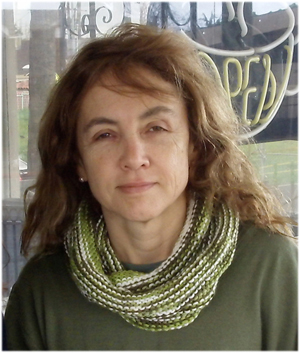 RENEE MONTGOMERY
RENEE MONTGOMERYBordering on the fringes of Koreatown, Crenshaw and Mid-Wilshire, Mid-City is a crazy-quilt of weird and wonderful adjacent cultures: Greek temples besides El Salvadoran 99 Cent Stores, Buddhist retreats backing up to Renaissance libraries, and Latina fortune tellers neighboring Korean driving schools. For three of the early years of TNN I covered the growing cultural beat, restaurants and architecture. Regularly cruising the neighborhood looking for stories, I wasn't on my route very long before I would encounter a new art gallery or, let's say, an Evangelical missionary parade. Favorite stories were the Yuppet marionettes , the legendary First A.M.E., the Black Doll Exhibit,
To me, Dianne Lawrence represents the Wild West success story, an immigrant finding a home in L.A., establishing a distinguished record of amazing artistry, rambling around in her old Volvo, building a business brick by brick. Although I moved to Oakie Oklahoma for family reasons, I fondly remember my time documenting Mid-City's ever changing culture in the Neighborhood News.
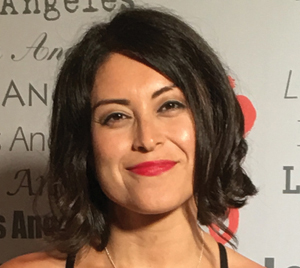 CARLA PINEDA
CARLA PINEDAWhen I bent down to pet Dianne's dog Foxie, I had been photographing a youth conference put on by a community leader at Leslie N. Shaw Park. I was fresh out of college, back at the 2nd Avenue home I grew up in with my parents and trying to reestablish my relationship with a community that had reared me from my first waddling steps to my adult life. I wanted to strengthen my relationship with my neighborhood while taking tentative steps into a career in journalism during some of its most uncertain times. I was also looking for a place where I could tell the stories of my community after spending the previous five years telling the stories of my college town.
With Foxy, came Dianne, and her friendly, curious and direct nature that has touched many of us in the neighborhood. “Fantastic. I’m starting a community newspaper. We should work together.” And just like that, we exchanged contact information and Dianne gave me an opportunity to join her growing power group of local contributors documenting the stories about a community in a way nobody else in the city was doing.
During the past 10 years, we’ve shared many phone calls, emails and conversations about where “Spirit” is taking us, not only for The Neighborhood News, but in life.
One of my favorite reports was about the giant Mid-City shopping development at San Vicente and Venice that blocked some of the best views in the neighborhood. Because I was working at a commercial real estate newspaper at the time, I took advantage of the expertise of my architect and engineer friends to help me analyze public records. We discovered the public had not been warned the views would change. In fact, the public records approved by city officials stated the development would have no change to the community’s aesthetics. The Neighborhood News kept up on the story for nearly two years as the community fought to have their councilmember finally address their concerns, and TNN was instrumental in bringing him to their table.
Another project that I was proud to take part in was our coverage of the homeless population that took place over a year. TNN consistently published resources for them and forged a bridge for the community to understand their less fortunate neighbors. I remember, in one day I went straight from interviewing the senior lead officer at the Los Angeles Police Department’s Southwest station to interviewing a homeless individual on the curb of a gas station.
Dianne has always thanked and shown appreciation to the team for making the past 10 years possible. But I’d like to take this opportunity to thank her personally for telling the stories my community deserves to hear and for helping me reintegrate into the community that raised me. The Neighborhood News assignments have unknowingly picked me up off the floor after defeat, heartbreak or the unforeseen. And I could not feel more grateful to TNN, Dianne or “Spirit” for their guidance.
{jcomments off}
Regina Jones' Got Soul
- Details
- Category: Interviews
- Published on Friday, 11 December 2015 22:54
- Written by Chelsee Lowe
 {jcomments off}Regina Jones grew up quickly. At the age of 10, she recalls spending time in the South L.A. beauty parlor where her mother worked.
{jcomments off}Regina Jones grew up quickly. At the age of 10, she recalls spending time in the South L.A. beauty parlor where her mother worked. Good customer service was a given there and eventually, Jones figured out that if she picked up clients’ lunches, her tips would add up to a decent personal budget. She also kept an eye on the family bills. Whenever a notice came from the Department of Water and Power, for example, she’d gather the funds from her parents, get a cashier’s check at the post office and put the payment in the mail.
At 15 years old, Regina married Ken Jones and began a family, raising five children, all about a year and a half apart. Her financial skills proved valuable immediately. While Ken made a living as a reporter and journalist, Jones was in charge of using those earnings to take care of the family’s fiscal matters.
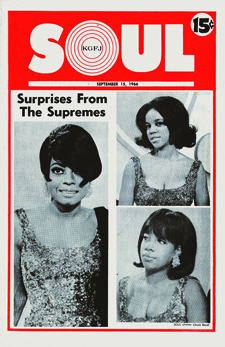 In 1966, the couple launched Soul, a publication dedicated to telling the stories of black entertainers of the 1960s, 1970s and early 1980s. It was the first magazine of its kind. Ebony and Jet existed, but the main focus wasn't entertainment, and when entertainers were featured, they were generally artists who had successfully crossed over into the white commercial market, such as Sammy Davis Jr., Lena Horne and Nat King Cole
In 1966, the couple launched Soul, a publication dedicated to telling the stories of black entertainers of the 1960s, 1970s and early 1980s. It was the first magazine of its kind. Ebony and Jet existed, but the main focus wasn't entertainment, and when entertainers were featured, they were generally artists who had successfully crossed over into the white commercial market, such as Sammy Davis Jr., Lena Horne and Nat King ColeRegina and Ken moved to Van Ness Avenue in Country Club Park in the same year the paper started. Regina still resides there. When the newspaper folded in 1982, Jones’ professional life continued. She spoke with TNN about Soul, her life in Los Angeles and her entrepreneurial nature.
TNN: Soul launched in April of 1966 and covered some of the biggest names in music history, James Brown and Aretha Franklin among them. What was it like to work with such icons?
Regina: I was really all about the nuts and the bolts. I went to the concerts, met the artists, and I enjoyed that. But that was all background for my constant thought: How will I get advertising in to pay for the publication, to pay the bills at home and to take care of the children? My motive was never “Go have fun.” It was a business. I was never a fan of an artist.
TNN: What gave your husband the idea to start Soul in the first place?
RJ: Soul was born out of the Watts riots. At that time, Ken was a runner for NBC news’ Huntley-Brinkley Report and on local radio stations; I was a radio operator for LAPD, and I got the first call for help that night. My husband watched Watts burn from the roof of a radio station. That’s when he thought, “Let’s do something better.” He came up with the idea for the newspaper.
TNN: Tell us about working side by side to create the newspaper for all those years.
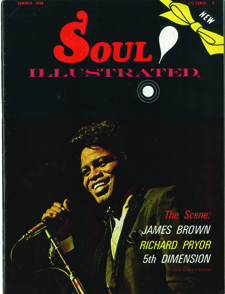 RJ: It was a small investment of money — we just had to pay the printer, so then if the issues sold, that money went to pay the printer next time. If you got an ad, you made more than it cost to print the issue. I was responsible for the books — advertising, sales, distribution, deadlines. I never got into the art side of things. That made my husband and I a good combination. He was the creative one. He would do anything to be on the radio or on television. He loved the music, the parties — if I was at a party, I was there to get an advertiser.
RJ: It was a small investment of money — we just had to pay the printer, so then if the issues sold, that money went to pay the printer next time. If you got an ad, you made more than it cost to print the issue. I was responsible for the books — advertising, sales, distribution, deadlines. I never got into the art side of things. That made my husband and I a good combination. He was the creative one. He would do anything to be on the radio or on television. He loved the music, the parties — if I was at a party, I was there to get an advertiser.TNN: Soul was associated with local radio station KGFJ. Later, it spread to Oakland then different cities across the country.
RJ: The instant success in Los Angeles made it clear we were filling a need and in less than one year we were being distributed in the top 30 markets across the country. At our peak we were publishing 127,000 copies. Ken came up with a unique marketing plan to affiliate with the top R&B radio stations in each city. By trading advertising space in the magazine and using their station's name on the cover, the radio stations gave us free advertising on air. Because of Soul, I received the NAACP Image Award for Outstanding Woman In Business in 1980.
TNN: What were some of the accomplishments of soul that you are most proud of.
 RJ: By documenting the history of black entertainment just before it crossed over into white mainstream we recognized and covered important artists early in their careers like Melvin Van Peebles, Bill Cosby, Flip Wilson, Cicely Tyson and Artist Lane whose bronze sculptor of Sojourner Truth was placed in the Capital Building in Washington DC. We were also a townhall for opinion pieces that reflected the political changes for African Americans in the 60's and 70's. The headline for our first cover was "White Artists Selling Negro Souls". You can find out more by going to our Facebook Page "Soul Newspaper".
RJ: By documenting the history of black entertainment just before it crossed over into white mainstream we recognized and covered important artists early in their careers like Melvin Van Peebles, Bill Cosby, Flip Wilson, Cicely Tyson and Artist Lane whose bronze sculptor of Sojourner Truth was placed in the Capital Building in Washington DC. We were also a townhall for opinion pieces that reflected the political changes for African Americans in the 60's and 70's. The headline for our first cover was "White Artists Selling Negro Souls". You can find out more by going to our Facebook Page "Soul Newspaper".TNN: What led you to close the publication in 1982?
RJ: My mother had become very ill, my marriage was falling apart, and Soul was in big trouble. There was an economic downturn and everyone was holding their pockets tight — it was a battle to pay the printer and pay staff. I knew I couldn’t work magic any longer. But it did feel like pulling the plug on one of my own children when we printed that last issue. I had emotionally reached a point where I didn’t care or know what others thought. I know many were disappointed.
TNN: What was your next move?
RJ: I stuck my head in the sand and tried to survive. I had teenage kids at home, so I did what I could do to not lose it. I started doing temp work, until a friend of mine at the Ladd Company reached out to me. She wanted me to work on the first “Police Academy” film as the assistant to Alan Ladd, Jr. I knew about deadlines and production. It was the same — my experience carried over. Later, [music producer] Dick Griffey asked me to do publicity for him. I was shocked, and I told him I didn’t know how to do that. He said he was willing to pay me for 6 months to prove that I did. I had five kids, so I took that job as the VP of publicity until he had to make cutbacks. That’s when I started my own firm: Regina Jones and Associates.
TNN: What sort of projects did you lead with your own firm?
RJ: My first really good account was The Geffen Company.As the firm grew, we started doing the NAACP Image Awards. I did 13 shows — at the Wiltern, then the Pasadena Civic Auditorium. It became a huge televised show, and my life was very high stress three to four months out of the year. Then Maxine Waters called me about a project she thought I was perfect for — a childcare development agency had opened a childcare center in Nickerson Gardens housing project, which was right across the street from my mother’s beauty shop and where I’d played as a child. I said I would do it, and later the ladies asked me to join their firm — Crystal Stairs, Inc. I kept my own PR work going on the side for awhile, but eventually I gave that side work up and focused just on Crystal Stairs. I liked working for non profit. After all those years in the entertainment world, it was nice to give back.
TNN: You’re officially retired now yet still busy. What are you up to?
RJ: I took on the role of Interim President of the Country Club Park Neighborhood Association (CCPNA) recently. I’ve been involved with the group for over 10 years, and I’ve discovered that my neighbors are also my friends. That’s a nice feeling… it’s a feeling of community and connection. We have an important thing in common — our homes. And that’s usually a person’s most valuable asset, and there should be community surrounding where you live. If there were to be a disaster, it’s not your family or friends who’ll be able to come to you. It’s your neighbors.
Learn more about Soul Newspaper on facebook, or visit the archives in their entirety at UCLA’s Charles E. Young Research Library.
Kitty Bungalow's Shawn Simons
- Details
- Category: Interviews
- Published on Thursday, 06 October 2016 17:23
- Written by Dianne Lawrence
 TNN:Tell me what your volunteers do?
TNN:Tell me what your volunteers do?Shawn: We call them teachers. We have 5 shifts a day and 13 people per day. We are a 100% feral cat rescue and the only all feral (wild) socialization [helping them feel comfortable with human contact] facility, so part of the work that's being done by our “teachers” is the socializing of the cats. We have different people that come in to help break down the cat's fears and anxiety levels. It's not just I'm going to go in and pet this one. You really have to know what level the cat is at, what is the next obstacle and what can I do to help get them over that next obstacle. There are different techniques and a “lesson plan” as we call them that can help them move through things.
Most organizations run things through foster networks and the cats may get used to that particular foster. In other facilities, a lot of times they don't let volunteers go into the feral room. We just discovered that the more people that are in there, touching them and breaking down those defenses the quicker they become tame and adoptable.
TNN:Do the volunteers do anything else?
Shawn: There's a lot of poop scooping and a lot of cleaning that is necessary. It addresses the medical care of the cats. You can't have some sloppy poo on the side of the litter box that hasn't been washed off because it may be covered in Giardia that someone else is going to step in and eat and re-infect. The other activity has to do with ease of use of the space for other volunteers. You have 80 different people coming and going so things need to go back where they belong.
TNN: Tell me about the activities of the TNR (Trap Neuter Return) volunteers.
Shawn: The foundation of Kitty Bungalow is built on TNR. While the group is smaller I have to say the TNR volunteers truly do some of our most important work. Feral cats are coming from the streets and they are coming from unfixed cats that are in your yard and behind the bush and maybe you didn't even notice that one because you didn't go out at 3:00 in the morning, but they are everywhere. It's those cats that are clogging up the shelter system and causing a kill rate in our city that is unpalatable.
TNN:What is that rate?
Shawn: For cats it’s about 50% of the cats brought in the shelter are killed. Dogs are at about 11% kill and an 89% live and release rate. 90% live is considered a no kill shelter. L.A. is almost there. It is the cats that are keeping us from no kill.
It should also be said that 76% of all of the animals killed at the city shelters are kittens 8 weeks and under. That has to do with the amount of time and attention that it takes to hold on to those kittens before they can become adaptable. Taking little stray or abandoned kittens into the shelter, they are most likely going to go out the back door dead. The TNR work that we do is prophylactically stopping the adult feral cats from having kittens that end up in boxes in the shelter.
Being a TNR volunteer is not as fluffy or adorable as being a teacher at Kitty Bungalow Charm School for Wayward Cats, but our truancy department really is the lifesaving work. Because of an ongoing injunction which is rolling into its 7th year, there is little that the city can do for feral cats. Adult feral cats that come into the shelter have to be held for 5 days per the state law, then they are marked for death because they are feral. But we have a new program. Thanks to the backing ofNKLA (No Kill Los Angeles) Coalition and Best Friends.
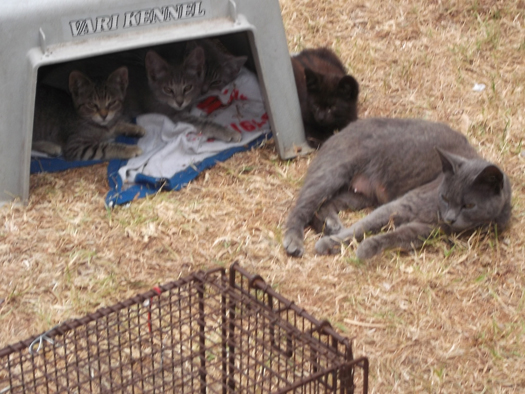
Best Friends came into Los Angeles and created a coalition called NKLA and invited all of the groups to come together and work together. As a much larger well-financed organization, they had the ability to help with grant funding and supporting the smaller organizations that are boots on the ground to really try and make some positive motion that the city can't do.
TNN: Do they support your activities?
Shawn: Best Friends gave us a grant for a program called Working Cats. Because of the injunction the shelters cannot release feral cats to rescue organizations. They have to be adopted. We are taking death row feral cats and our Working Cat program finds businesses that are looking for mousers to adopt and we've had some really good success with some local breweries, with some horse farms. We are looking to expand that program to help those cats. It's their only way out.
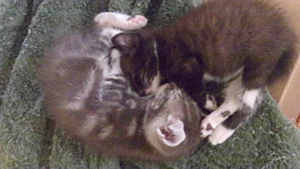 TNN: Any businesses that have a mouse problem and might need some feral cats should also contact you. How long has that program been in place and how is it working?
TNN: Any businesses that have a mouse problem and might need some feral cats should also contact you. How long has that program been in place and how is it working?Shawn: For about a year. It is a very difficult program to launch. We are a volunteer-run organization and for every program that we add it adds additional work. But I feel confident we can build on the success of this year.
TNN: Am I hearing you say you need additional volunteers?
Shawn: Yes. We also just bought a new space and will be moving into it on Martin Luther King between Western and Venice. It will triple the space of our organization and also provide a resource center for community. A lot of people who need us most don't know that they can Google us. They don't know that there are loonies like us that are dedicating our lives to do this.
TNN: What kind of people need you the most?
Shawn: I think a lot of lower income, a lot of immigrant neighborhoods.
TNN: They are experiencing large feral cat colonies?
Shawn: Exactly. I think young Hollywood and affluent areas know about TNR so they look us up and they find us but they have the capacity to handle the situation with just some support from us rather than turning over the responsibility to us. We can support them but need them to be more involved in the rescues so that we can really guide our limited resources to the areas that really, really need the help.
TNN: What kind of volunteer skills are you looking for?
Shawn: All kinds. A lot of our volunteers really love animals but in order to run an animal organization, you also need people who can talk to people, to reach out and be what we call Kitty Bungalow cheerleaders. People who can go out into the community and do events, be at the farmer's market and help to let people know that we are around and can be of help and they can come to us and adopt the animals. They can donate. We also need people who can be a bus driver twice a month and drive our cats to the vet. That works for those people who have very busy lives. I need someone who can help me clean out my computer so the little round spinning thing stops giving me vertigo.
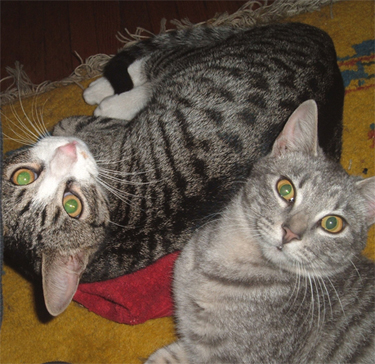 TNN: Walk us through what happens when somebody has discovered or is dealing with a feral colony and they need your help.
TNN: Walk us through what happens when somebody has discovered or is dealing with a feral colony and they need your help. Shawn:The best way to reach us is on our website. While we carry our phones around all the time, we are usually covered in cats or in the middle of something and don't really have a lot of time to answer the phone. On our website, you can find the category for your problem. If you have feral cats, there is an application to fill out and put as much information as you have. The more you include, the quicker we can work out a plan with you and your particular situation. I have noticed from running a charity for 7 years that people want the charity to do it. The persons good deed is calling the charity and passing the cat on. "Okay, I'm going to do something good. I'm going to call this charity and I'm going to get them to take care of this."
TNN: I think anybody who does rescue work is familiar with that. They are the person in the neighborhood who everybody calls.
Shawn: What we are looking for is partnerships. Working with people who can assist us as we assist them so we can be more fully available for those people who have no resources but want to help. Maybe they can't take an animal in or are being hounded unfairly by a landlord or they don't have a mode of transportation, or a network.
Now if we are dealing with a very large colony, we send out a team and we work with the community partner to get the cats fixed. If somebody contacts us and says, "There are 3 cats in my backyard." Super! We will arrange for a date for you to come up and pick up some traps. We'll show you how to use them. We'll get you set up for a free spay neuter appointment so you can take them directly in and you are done.
TNN: That happens a lot I would imagine.
Shawn: I think it was a little over a year ago where I had someone send me a photo of this little kitten in this guy's hand. He was asking us to take this kitten in. My point to him was that you don't need us. You already rescued this cat. What you need is support from us. I'll make an appointment for you to bring the kitten in. We'll vaccinate the kitten for you. We'll do the med check for you. We will set up a spay neuter appointment for you. If you are a crappy photographer we'll set up a photography session for you. In this day and age where most people have their 450 Facebook friends, finding a home for 1 adorable kitten is not that tough. If you brought that cat in and it screamed and bit everyone, then we would take that cat in because he’s too feral to place. That's what we do. That's our specialty.
TNN: Tell me a about this fundraiser you’ve got coming up.
Shawn: The Catbaret. This will actually be our 6th annual celebrity event. There's nothing like it. I've produced award shows and I've produced charity fundraisers and usually the celebrities are there and they read off a teleprompter and they introduce someone. Our celebrities sing and dance about cats. It's a really, really fun show. I swore at the beginning that we would raise funds for production through corporate sponsors and whatever money we got was our budget. If we had to do it in my backyard, then we would have to do it in my backyard.
So all the money from the tickets goes directly to the mission, goes directly to the cats. It's all put on by a volunteer army. We need to sell out our event on Oct. 15 in order to raise a lot of money so we can do what we need to do with the new space and hopefully continue to expand our programs and our reach and our donor base and be able to truly help move the needle at the shelter to no kill.
TNN: Anybody who might be interested in helping your organization, contributing to your organization, volunteering for some of these programs would just contact you directly Kitty Bungalow.
Shawn: Yes. If you go to our website, there's a volunteer tab and you can fill out information there. We usually have orientations every other month. You can also find out about our Catbaret event. Come and support us and have a great evening!
http://www.kittybungalow.org/
The Nicholas Brothers Remembered
- Details
- Category: Interviews
- Published on Sunday, 11 October 2015 00:36
- Written by Chelsee Lowe
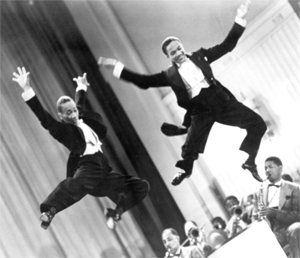 Fayard and Harold Nicholas made a name for themselves with their feet. From the ages of 14 and 7, the brothers impressed crowds worldwide with their electric tap dancing skills. Though they passed in 2006 and 2000 respectively, the Nicholas Brothers’ legacy lives on through their children, grandchildren and great grandchildren, including Tony Nicholas, director of Tom Bradley International Source Center on Pico Boulevard. Tony, son of Fayard Nicholas, hopes to stage a Nicholas Brothers tribute show at a local theater soon. He spoke with The Neighborhood News about his father’s life in Los Angeles and beyond.
Fayard and Harold Nicholas made a name for themselves with their feet. From the ages of 14 and 7, the brothers impressed crowds worldwide with their electric tap dancing skills. Though they passed in 2006 and 2000 respectively, the Nicholas Brothers’ legacy lives on through their children, grandchildren and great grandchildren, including Tony Nicholas, director of Tom Bradley International Source Center on Pico Boulevard. Tony, son of Fayard Nicholas, hopes to stage a Nicholas Brothers tribute show at a local theater soon. He spoke with The Neighborhood News about his father’s life in Los Angeles and beyond.TNN: What will the upcoming tribute show be like?
Tony Nicholas: What we’ve done is taken Nicholas Brothers moments — pictures, film clips of dance routines, plus two reenactments — and combined them into an amazing show. It begins with family members on stage. The MC usually asks us a series of questions and we tell stories. After that, my two grandchildren come out. A clip from the film “Lucky Numbers” plays behind them, and they sing the song with the clip. After that, my daughters come on stage to do the “Lucky Numbers” tap routine. It’s incredible.
TNN: You’ve shared that four generations of your family have tap danced at this point. How did that tradition begin?
Tony: My father was born in 1914 in Mobile, Ala., and my uncle was born seven years in later in Winston-Salem, N.C. My grandparents later moved to Philadelphia — they were in Vaudeville, and they performed the Vaudeville circuit along the east coast. My grandmother played the piano, my grandfather played the drums, and they had a base player in their group. My father would travel with them as well. He’d be in the audience, watch the dancers and mimic them. He taught himself how to dance, and later he taught his brother.
 Tony with Dad Fayard
Tony with Dad FayardTNN: How did they become professional dancers?
Tony: One day, my father and uncle performed for their parents. And in regular church shoes, because tap shoes weren’t a thing yet. My grandfather knew there was something there. My grandparents quit Vaudeville and started promoting their kids. My father was 14 and my uncle was 7.
They started at the famous Standard Theater in Philly. A promotor saw them dance and said, “Listen, I wanna bring you to New York City to perform at the Cotton Club.” And they did. They were there with all the famous black entertainers of that time — Lena Horne, Count Basie, Duke Ellington and more. The Nicholas Brothers were so talented that none of the other acts wanted to follow them. So they had to close the show every night. They did that for years. Then Hollywood called.
TNN: What happened when they came to L.A.?
Tony: They just visited at first — they shot the film “Kid Millions” — then they went back to The Cotton Club. But when the venue closed down in 1940, they went to Europe to find work — black performers were well-loved in Europe, so there were more jobs there than in the U.S. When World War II started, they returned to the states. My father was drafted and he became a part of the United Service Organization. He performed for the soldiers.
TNN: What happened when the war ended?
Tony: When my father got out of the army, he and my uncle signed a contract with 20th Century Fox to do six films. They lived here in L.A. at that point, and by then my father had married my mother, who he met while performing in Chicago. She wanted to buy a house on the westside of L.A. but she wasn’t allowed to. At that time, blacks couldn’t buy homes west of Arlington. She tried to buy a house right on Arlington, but when nothing was available she went one street over. We lived on Van Ness, a couple of blocks north of Exposition.
(One block over, was Cimmaron where Eddie Anderson, the African American actor who played Jack Benny's butler Rochester, built a house that was the exact replica of Jack Benny's. He was not allowed to buy in Beverly Hills.) Our family bought the house in 1945, around the time I was born. Mom started picketing City Hall around then as well. There was a photo of her, myself in a buggy and a sign that reads, “L.A. is Unfair to Negros” in the L.A. Times.
With Bob Hope
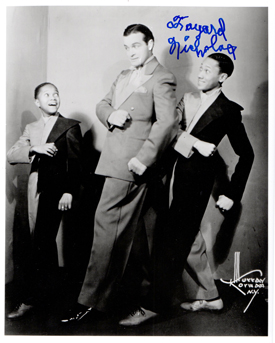
TNN: How did the filming of the movies go for The Nicholas Brothers?
Tony: They shot the films from 1945 to 1951. But one of my favorite stories is from the signing day. They went to see Darryl F. Zanuck, head of 20th century Fox and one of the most powerful men in all of Hollywood. Zanuck said he wanted to find another star on the grounds — he wanted someone to take a photo with my father and uncle as they signed the contract. So he told them to go have lunch. They went to the commissary and were turned away by the maitre d’, who told them they had to go around back and get sandwiches. An executive saw what happened, told Zanuck, and Zanuck came down and fired everyone. That same day — that quick — he got new workers, found my father and uncle and had lunch with them in the commissary. He also found Fred Astaire. So Fayard and Harold danced with Fred Astaire right there on the lot, and my uncle’s valet recorded it on his video camera.
TNN: Many other incredible stories unfolded for them — and you — as they continued to dance. Can you share another of your favorites?
Tony: After the contract film wrapped, we headed back to Europe. At one point, we were staying at a villa in Rome. I was dancing by then, too. I was 5 years old. One day, a priest came up to us, talked to my mother, and we got in a limo that took us to the Vatican. We were ushered in to see the Pope, and I danced for him. I had been performing with the Nicholas Brothers, and he had heard wind of this little dancer. He wanted to see me for himself. We have it all on film, too. And he gave me a special blessing — that’s why I feel I’ve been blessed all my life.
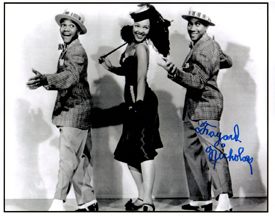 With Dorothy Dandridge
With Dorothy DandridgeTNN:Were there any other one-of-a-kind performances?
Tony: Not too long after that, we moved to Paris then London, where we gave a command performance for Queen Elizabeth. She was in the royal box and pregnant. She went into labor and had to leave, but the Queen Mother stayed — she wouldn’t leave until she’d seen us. After The Nicholas Brothers performed, I had my turn. The next day, the Queen Mother invited us to Buckingham Palace — we have a film of her holding my hand and walking through the rose garden. I’ve been waiting to meet that child — Prince Charles — to tell him that his grandmother wasn’t at his birth because she wanted to see me dance. And all of these home movies are stored at the Motion Picture Academy here in L.A. You can go watch them! They’re also part of the National Library of Congress.
TNN: What did your father's dancing career look like in his later years?
Tony: My mother and father had problems, and eventually she divorced him and we came back to the house on Van Ness. Tap dancing fell in popularity in the 50s and 60s — my father took work as a night watchman at a L.A. factory. But then in the 1970s, tap dancing came back, with a little help from Gregory Hines and Sauvignon Glover. People rediscovered The Nicholas Brothers. My uncle came back from Europe, where he’d stayed and performed solo. They started working in television, at the Hollywood Palace, everywhere. They performed before seven presidents; they received a Kennedy Center Award in the 1990s. Eventually, my own daughters were dancing, too. As a family, they danced together at Carnegie Hall, at the Hollywood Palladium, even in Cuba.
TNN: What a legacy. What about the fourth generation?
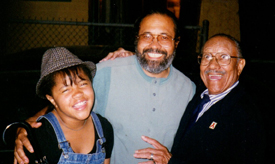 Tony: I have two grandchildren now, and they’re dancing— they’re good and they love it. My granddaughter was here [at the Tom Bradley International Source Center] the other day. Someone asked her, “What do you want to be?” She said, “A doctor, but I want to be a dancing doctor.”
Tony: I have two grandchildren now, and they’re dancing— they’re good and they love it. My granddaughter was here [at the Tom Bradley International Source Center] the other day. Someone asked her, “What do you want to be?” She said, “A doctor, but I want to be a dancing doctor.”Watch one of the most famous Nicholas Brothers' performances at
www.youtube.com/watch?v=zBb9hTyLjfM
More Articles...
Today6
Yesterday9
Week15
Month34
All988076
Kubik-Rubik Joomla! Extensions
Yesterday9
Week15
Month34
All988076
Currently are 101 guests and no members online
Kubik-Rubik Joomla! Extensions



